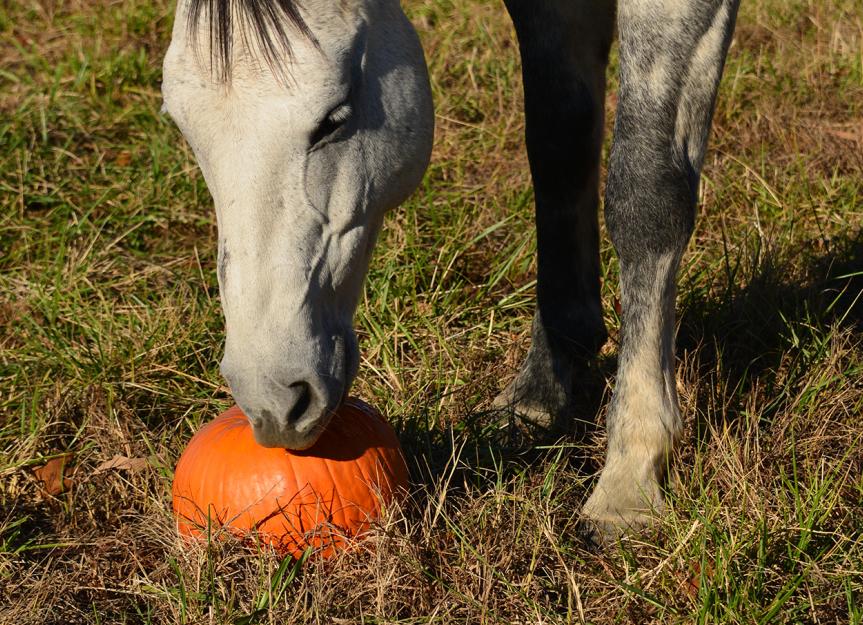
NOTE: Always check with your veterinarian before giving your horse any new foods, especially people food. What may be ok for a horse may not be good for your horse, depending on several factors such as their age, health history, health status and diet.
If you are a fan of pumpkin-spiced lates and pumping muffins, maybe you wonder, can horses also have pumpkin? Yes, they can of course – in measure.
“Orange pumpkins are safe, including the skin, seeds and filling inside,” says Emma Kerr, DVM, a horse veterinarian trainee at Vermont Large Animal Clinic in Milton, Vermont. “They shouldn't have gourds or squash.”
Like all other treatments, pumpkins should supplement a horse's diet, rather than replace any part of the horse's hay or concentrate ration. It should also not be used as a compensation for any medicines. Feeding a well -balanced diet is necessary to keep your horse healthy.
Key dealers
- Common raw, cooked and 100% pure canned pumpkin (without added ingredients) is a good treatment, especially for horses with horse metabolic syndrome and polysaccharide storage myopathy.
- Pumpkin contains a lot of potassium and should not be fed to horses with hypercalmic periodic paralysis; Excess potassium is not recommended for horses with this genetic condition.
- Avoid feeding horses pumping pie filling, seasoned pumpkin or moldy pumpkins to avoid digestive problems and toxic ingredients.
Is pumpkin good for horses?
There are few studies on the health benefits of feeding pumping for horses, but pumpkin has generally been shown to include important nutrients that support digestion and overall cellular and immune health. These essential nutrients include:
Pumpkin seeds also contain nitric oxide, which in human research has been shown to play important roles to promote a healthy blood flow, memory, pancreas function and sense of smell.
Can pump be bad for horses?
Pumpkin is generally good for horses to eat, including horses with metabolic problems.
Although pumpkin has a high glycemic index, the sugar in the bloodstream is slowly absorbed, making it safer than other goodies for horses that are prone to laminit, says Dr. Kerr.
However, Pumpkins contains potassium, which is problematic for horses with horses that must have low potassium diets.
How much pump can my horse eat?
Treats of some kind should be fed in measure. A horse's diet should first be designed around feed (hay and grass), feed and supplements based on the needs and sweets of the individual horse as just that – a treatment.
Fruits, including pumpkins, should be fed with dimensions, which is a maximum of 1% of your horse's daily diet. The rest should come from a well -balanced diet based on recommendations from your veterinarian and/or a horse industry doctor.
Safe pumpkin serving size for horses
Pumpkin should be introduced slowly and given to horses in limited quantities. “For metabolic horses, keep portions on the lower end of things,” says Dr. Kerr.
Below is a general guide for serving sizes, but your veterinarian can recommend specific quantities for your horse.
| Small (below 600 pounds) | ½ cup | 1 teaspoon | Once a day |
| Average (600–1 100 pounds) | 1 cup | 2 teaspoons | Once a day |
| Big (1 100+ pounds) | 1½ cup | 1 tablespoon | Once a day |
How to safely feed pumping to horses
Before feeding your horse pump, it is important to prepare it properly. Raw pumpkin can be a choking risk.
“Horses that suffocate can have a nasal emissions that come from the nostrils or have saliva around the mouth,” says Dr. Kerr. “If they look like they are in need and have any of these symptoms, it's an emergency and you have to call your veterinarian.”
To prepare raw pumpkin:
Dr. Kerr says that adding pumpkin pieces to hanging horse toys, such as the Petkore Luna ring, in booths or voters can make a treatment for an enrichment experience to strike boredom.
To prepare boiled pumpkin:
You can skip the trouble of cooking pumping and choosing preserves instead. Always read the label to ensure that it is not pumping pie mixture and that it contains no additives.
What to do if your horse eats too much pumpkin
When feeding something new, look at your horse for signs of discomfort. The same applies if your horse overwinds in pumpkin. If you suspect your horse has eaten too much pumpkin, observe them for a few days.
Call your veterinarian directly if your horse shows the following signs of colic:
While most healthy horses can eat pumpkin without problems, each horse is an individual. Older horses, those with dental problems or those with certain health conditions may need to avoid it completely.
Ask your veterinarian or a horse industry if you are worried about feeding pumping for your horse.
Can horses eat pumpkin common questions
Can foals eat pumpkin?
No, foals should not eat pumpkin until they have a full set of teeth.
Is raw or boiled pumpkin better for horses?
Both raw and cooked pumpkin are good for horses, although the serving size varies.
Can horses eat pumpkin seeds?
Yes, horses can eat pumpkin seeds.
Can horses eat pumpkin bowels?
Yes, horses can eat pumpkin bowels.
Can horses eat pumpkin pie?
No, horses should not eat pumpkin pie, which usually includes ingredients that are uncertain for horses.
Can horses eat canned pumpkin?
Horses can eat 100% canned pure pumpkin, but they should not be fed preserved pumpkin pie mixture or canned pump with additives such as salt or sugar.

